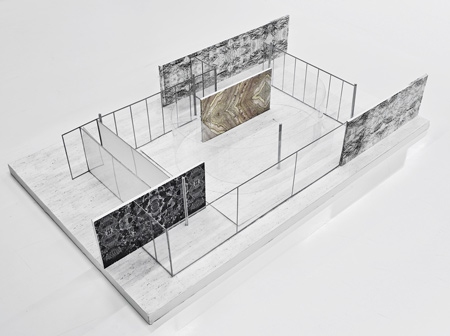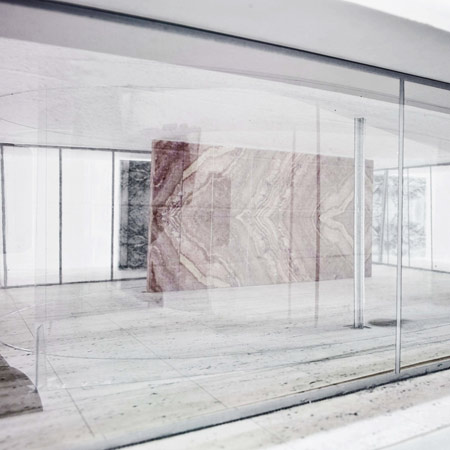728x90




Japanese architects SANAA will create an installation at the Mies van der Rohe Pavilion in Barcelona, Spain, this month.
The project will consist of acrylic curtains arranged in a spiral within the pavilion, reflecting and distorting views through the structure.
“We decided to make transparent curtains using acrylic material, since we didn’t want the installation to interfere in any way with the existing space of the Barcelona Pavilion,” says Kazuyo Sejima of SANAA.
“The acrylic curtains rest lightly on the floor and adopt the form of a sinuous spiral. The curtain adapts smoothly to the Pavilion’s inner space to create a new atmosphere. The view through the acrylic material is rather different from the original one, in that it generates gentle reflections that slightly distort the Pavilion.”
The installation will be open to the public from 26 November 2008 until 18 January 2009.
The following informatition is from the Mies van der Rohe Foundation:
___
SANAA INSTALLATION AT THE MIES VAN DER ROHE PAVILION
(November 26 2008 ? January 18 2009)|
The prestigious Japanese SANAA architecture studio, founded and run by Kazuyo Sejima and Ryue Nishizawa, has been selected by the Mies van der Rohe Foundation to create an installation for the Barcelona Pavilion in the winter of 2008-2009.
The installation, on which the Japanese studio has been working for several months, will be open to the public from November 26 2008 until January 18 2009.
Kazuyo Sejima and Ryue Nishizawa are known internationally for their subtle, meticulous architecture and for their ability to address complex projects through a deceptively simple approach. Their built works include the New Museum of Contemporary Art in New York (2003-2007) and the Issey Miyake and Christian Dior stores on Tokyo’s main shopping avenue (2003). In 2004 they were awarded the Golden Lion at the IX Venice Biennale.
Installations at the pavilion
This piece forms part of what has become a firmly established programme of installations ? conceived as light, short-duration exhibitions or interventions ? at the Mies van der Rohe Pavilion. The Pavilion provides the opportunity to work with creative formats that may occasionally be supplemented by other activities.
The periodical programming of installations at the Pavilion offers the city of Barcelona the chance to host unique works which, thanks to the creativity of both Spanish and international artists and architects, reinterpret and update one of its major cultural assets, the Mies van der Rohe Pavilion.
Other artists and architects who have executed installations for the Pavilion include Inaki Bonillas, Enric Miralles and Benedetta Tagliabue, Inigo Manglano-Ovalle, Jeff Wall, Jerome Schlomoff, Ulrich Meister, Panamarenko, Angela Bulloch & Joachim Grommek, Lluis Casals, R.D. Adela, Dominique Gonzalez-Foerster & Jens Hoffmann, Kay Fingerle, Philippe Terrier-Hermann, Thomas Ruff, Victor Burgin, Claude Rutault and Dennis Adams.
About SANAA
Kazuyo Sejima (Ibaraki, Japan, 1956) and Ryue Nishizawa (Kanagawa, Japan, 1966) worked independently from each other before founding the SANAA Ltd. studio in 1995. Having studied architecture at the Japan Women’s University, Sejima went on to work for the renowned architect Toyo Ito. She set up her own studio in 1987 and in 1992 was proclaimed Young Architect of the Year in Japan. Nishizawa studied architecture at the Yokohama National University. In addition to his work with Sejima, he has had his own practice since 1997.
The studio has built several extraordinarily successful commercial and institutional buildings, civic centres, homes and museums both in Japan and elsewhere. These include the O Museum in Nagano (1999) and the N Museum in Wakayama (1997), the Day-Care Center in Yokohama (2000), the Prada Beauty Store in Tokyo and Hong Kong (2001), the Issey Miyake and Christian Dior Building in Tokyo (2003) and the 21st Century Museum of Contemporary Art in Kanazawa (2004). Sejima also designed the famous Small House in Tokyo (2000), the Toledo Museum of Art Glass Pavilion, Toledo, Ohio (2001-2006), the extension to the Institut Valencia d’Art Modern, Valencia, Spain (2002 - ), the Zollverein School, Essen, Germany (2003-2006), the New Museum of Contemporary Art, New York (2003-2007) and the Novartis Campus WSJ-157 Office Building, Basle, Switzerland (2003 - ).
In 2004 Sejima and Nishizawa were awarded the Golden Lion at the 9th Venice Architecture Biennale for their distinguished work on the Metamorph exhibition.
The Mies van der Rohe Foundation
Founded in 1983 by the Barcelona City Council, the Mies van der Rohe Foundation’s initial mission was to reconstruct the German Pavilion designed and built for the 1929 Barcelona International Exhibition by Ludwig Mies van der Rohe (1886-1969). In addition to conserving and promoting the Mies van der Rohe Pavilion, the Foundation fosters debate on contemporary architecture and urbanism as well as striving to stimulate interest in and awareness of aspects related to these disciplines. It also encourages study of the work of Ludwig Mies van der Rohe and of the Modern Movement in general. The Foundation organises awards, congresses, conferences, exhibitions, workshops and installations.
So far in 2008 the Foundation has programmed a film cycle under the title of Ciudades Asediadas (Besieged Cities), curated by Le Jeu de Paume; a poetry cycle curated by Antoni Mari; the Coup de Des architecture seminar, chaired on this occasion by Inaki Abalos; and the SANAA installation curated by Xavier Costa. Furthermore, preparations are under way for the 11th edition of the European Union Prize for Contemporary Architecture ? Mies van der Rohe Award, which will be presented in 2009.
그리드형
'Pavilion&Installation' 카테고리의 다른 글
| [ Pearce Brinkley Cease + Lee PA ] Fayetteville Festival Park (0) | 2008.11.29 |
|---|---|
| [ Riccardo Giovanetti ] Plasticamente Pavilion (0) | 2008.11.29 |
| [ stacylevy ] Tide Flowers (0) | 2008.11.25 |
| [ stacylevy ] Wind Rain and Pollen (0) | 2008.11.25 |
| [ISAR] mOCEAN (0) | 2008.11.25 |